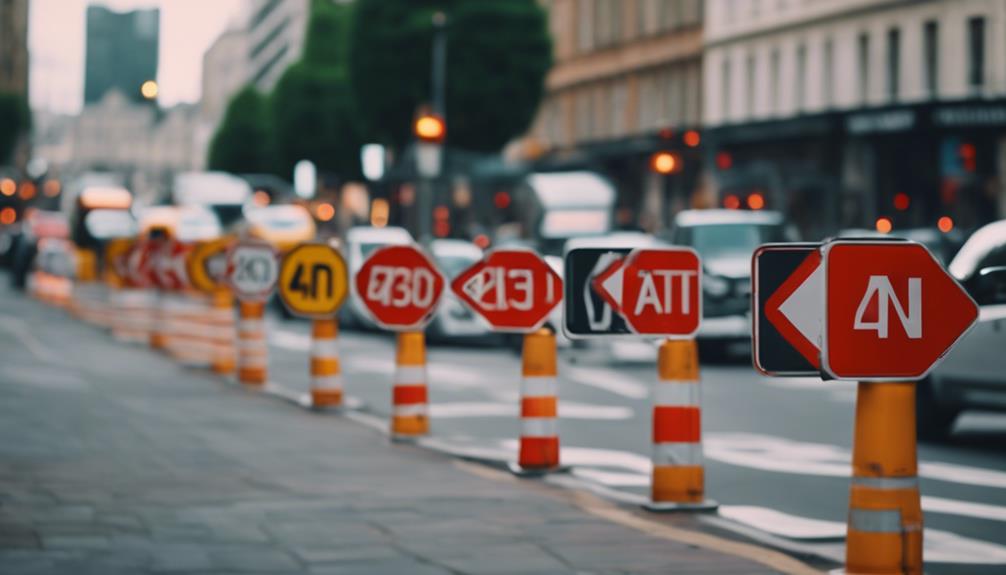Road signs are essential for our safety and guiding us on the road. They warn us about dangers, tell us where to go, and help prevent accidents. By following signs, we make driving safer for ourselves and others. Signs increase driver awareness, communicate essential information, and maintain traffic order. They use colors and symbols to convey messages quickly. Signs play different roles like regulating speed, warning about hazards, and giving directions. Remember, road signs are important tools that keep our roads organized and help us navigate smoothly. Understanding their significance is critical for safe and efficient driving.
Key Takeaways
- Road signs regulate traffic flow and warn about hazards.
- Signs provide directions, reducing accidents and promoting safer driving.
- They enhance driver awareness and communication on the road.
- Different types like regulatory and warning signs guide and inform road users.
- Adhering to signs ensures order, safety, and consistency on roads.
Importance of Road Signs
Road signs play an essential role in ensuring road safety by conveying important messages to drivers and road users. Traffic signs are key tools that help regulate traffic flow, provide warnings about potential hazards, and give directions to drivers. By following these signs, drivers can make informed decisions that reduce accidents and promote a safer driving environment for everyone on the road.
One of the primary purposes of traffic signs is to reduce accidents. These signs alert drivers to upcoming road conditions, such as sharp turns, pedestrian crossings, or construction zones, allowing them to adjust their speed and behavior accordingly. For example, a 'Yield' sign instructs drivers to give the right of way to oncoming traffic, preventing collisions at intersections. Similarly, speed limit signs help control vehicle speeds, reducing the likelihood of accidents caused by excessive speeding. Overall, consistent adherence to traffic signs is essential in minimizing accidents and creating a harmonious traffic flow.
Role in Road Safety

Road signs, such as speed limits and warning signs, are crucial for enhancing driver awareness on the road. They provide essential information about upcoming hazards or changes in the road conditions, helping drivers stay safe.
Enhancing Driver Awareness
Improving driver awareness greatly contributes to enhancing road safety by ensuring that important information about road conditions and potential hazards is effectively communicated. Road signs play a vital role in keeping drivers informed and alert while on the road. Here are some key ways in which road signs enhance driver awareness:
- Alerting drivers to speed limits
- Providing instructions for upcoming turns
- Warning about potential hazards ahead
- Guiding drivers on the right of way
Providing Vital Information
Enhancing driver awareness through clear and informative road signs greatly contributes to the overall safety and efficiency of road travel. Traffic signs and rules are designed to provide essential information to drivers, helping them make informed decisions on the road.
These signs alert drivers about potential dangers, upcoming turns, speed limits, and other important instructions. By following the guidance provided by road signs, drivers can navigate safely, reduce the risk of accidents, and ensure a smooth flow of traffic. The colors, shapes, and symbols used on road signs convey specific messages that help drivers anticipate road conditions ahead.
Preventing Accidents Effectively
By providing clear guidance and warnings to drivers, road signs play an essential role in preventing accidents and ensuring road safety.
Effective traffic safety measures rely heavily on the presence of warning signs that alert drivers to potential dangers and changes in road conditions. These warning signs help reduce the likelihood of collisions by prompting drivers to adjust their speed and driving behavior accordingly.
Additionally, by promoting adherence to speed limits and traffic regulations, road signs contribute greatly to minimizing accidents caused by non-compliance.
Moreover, the strategic placement of signage aids in the smooth flow of traffic and reduces confusion among drivers, thereby decreasing the risk of accidents due to misunderstandings or lack of information.
Communication Through Signs

Road signs effectively convey important information to all road users, ensuring safe and efficient travel. Pedestrian crossing signs alert drivers to areas where pedestrians may be crossing, prompting them to slow down and yield. Regulatory signs, such as speed limits and stop signs, provide clear instructions that must be followed to maintain order and safety on the roads.
These signs use consistent symbols and colors to aid in quick recognition and understanding. For example, the color red often indicates prohibitions or restrictions, while yellow warns of potential hazards. Understanding these signals is essential for safe navigation and smooth traffic flow. Drivers and pedestrians alike must be able to interpret and respond to road signs promptly and correctly.
Types of Road Signs

Different categories of signs play essential roles in guiding and informing road users. When it comes to types of road signs, there are several key categories to be aware of:
- Regulatory Signs: These signs are important for controlling traffic speed and the flow of vehicles on roadways. They inform drivers about rules and regulations that must be followed to guarantee safety for all road users.
- Warning Signs: Alerting drivers about upcoming hazards or dangerous conditions, warning signs are essential for promoting awareness and caution on the road. They help drivers anticipate potential risks and take necessary precautions.
- Pedestrian and Bicycle Signs: These signs designate specific areas for pedestrians and cyclists, ensuring their safety and guiding them on where it's appropriate to walk or ride.
- Guide Signs: Providing directions and information about highways and major landmarks, guide signs are crucial for helping drivers navigate unfamiliar roads and reach their destinations safely.
Significance of Regulatory Signs

Driving on the roadways effectively depends greatly on understanding the importance of regulatory signs in maintaining order and ensuring safety for all drivers. Regulatory signs play a crucial role in controlling traffic speed and flow by imposing specific rules and regulations. These signs inform road users about legal requirements, restrictions, and prohibitions on the road. Examples of regulatory signs include speed limit signs, stop signs, yield signs, and no parking signs. By adhering to the instructions on these signs, drivers contribute to smooth and safe traffic flow. Ignoring regulatory signs can lead to chaos, accidents, and violations of traffic laws. As such, it is essential for all road users to recognize the significance of these signs and follow them diligently. Remember, regulatory signs are important tools that help maintain order, safety, and consistency on the roads for the benefit of all drivers.
| Regulatory Sign | Description | Importance |
|---|---|---|
| Speed Limit Sign | Sets maximum speed allowed on a specific road | Ensures road safety |
| Stop Sign | Requires a complete stop at an intersection | Prevents collisions |
| Yield Sign | Indicates yielding to other vehicles | Facilitates smooth traffic |
| No Parking Sign | Prohibits parking in a designated area | Prevents congestion |
Impact of Warning Signs

Warning signs play a vital role in keeping us safe on the road. They alert us to potential dangers ahead, like sharp curves or slippery roads.
Reduces Accidents Significantly
By effectively alerting drivers about potential hazards ahead, warning signs play an important role in greatly reducing accidents on the road. Proper placement and visibility of these signs are essential in ensuring driver safety. Here are four key ways warning signs contribute to accident reduction:
- Early Warning: Warning signs give drivers advanced notice of potential dangers, allowing them to react promptly.
- Speed Adjustment: These signs prompt drivers to adjust their speed according to the road conditions, preventing accidents.
- Improved Preparedness: By providing essential information, warning signs help drivers prepare for unexpected situations effectively.
- Collision Prevention: Accurate warning signs help in preventing collisions by guiding drivers away from hazards.
The impact of warning signs on accident reduction underscores their significance in maintaining road safety.
Promotes Driver Awareness
Alerting drivers to potential hazards and road conditions is the primary role of warning signs. These signs are strategically placed along roads to provide essential information, such as sharp curves, pedestrian crossings, or icy conditions ahead. By conveying these warnings effectively, drivers are prompted to adjust their speed and behavior, reducing the risk of accidents.
The bold colors and symbols used on warning signs are designed for quick recognition, ensuring that drivers pay immediate attention to the message displayed. Overall, driver awareness promoted by warning signs is essential in helping all road users anticipate and respond to potential challenges, ultimately contributing to the goal of preventing accidents and ensuring safe travel for everyone.
Enhances Road Safety
Enhancing road safety through the effective use of warning signs is an essential aspect of ensuring a secure driving environment for all travelers. Warning signs alert drivers about potential hazards on the road, such as sharp curves or slippery conditions, helping to reduce accidents by providing advance notice of dangerous situations. These signs play a vital role in enhancing road safety by giving drivers time to react and adjust their driving.
They're designed with specific symbols and colors to convey quick and clear messages to drivers. Proper placement and visibility of warning signs are essential for ensuring road safety and preventing accidents.
Ordering Traffic Signs

When it comes to ordering traffic signs, Connecting Signs provides a variety of standard and custom options tailored to individual needs. These signs are essential for every road user as they convey important information that guarantees safe and efficient travel. Whether you require standard highway signs or personalized signage solutions, Connecting Signs offers a wide range to meet your specific requirements. Their consulting services further facilitate the process, allowing for personalized sign designs that cater to unique circumstances.
Placing an order for traffic signs is a straightforward process with Connecting Signs. By calling 970-493-0133, you can easily discuss your needs and preferences with their team. Additionally, requesting a quote for your desired signs is quick and convenient, enabling you to plan effectively for your signage requirements. With Connecting Signs' expertise in traffic sign solutions, you can rest assured that your needs will be met with professionalism and accuracy.
Frequently Asked Questions
Why Are Signs Important to Us?
Road signs are important to us because they provide vital information to drivers, alerting them about sudden changes ahead. The color of road signs indicates what to expect on the road, helping drivers anticipate and prepare accordingly.
Road signs are essential for road construction safety, ensuring the safety of both drivers and construction workers. They play a key role in ensuring the safe arrival of passengers and pedestrians at their destinations.
What Are Road Signs Their Meaning and Importance?
Road signs are important for safe driving. They provide essential information on rules, hazards, and directions. Understanding their meanings is critical for preventing accidents and following traffic laws. Each sign has a specific shape, color, and symbol for easy identification.
Neglecting road signs can lead to confusion, accidents, and legal consequences. Hence, it's important to pay attention to road signs to guarantee everyone's safety on the road. Additionally, road signs and nighttime visibility play a crucial role in ensuring drivers can navigate safely in low-light conditions. Properly illuminated and reflective road signs help prevent mishaps by offering clear guidance even in the dark. Ensuring visibility at all times significantly reduces the risk of accidents.
What Are the Benefits of Street Signs?
Street signs play an essential role in ensuring road safety and smooth traffic flow. They provide important information about road conditions, regulations, and potential hazards, helping drivers navigate safely.
One interesting statistic is that 75% of drivers rely on street signs for directions. These signs use different colors to convey specific messages, such as red for stop and yield.
Proper placement and visibility of street signs are critical for guiding drivers and pedestrians effectively.
What Is the Purpose of Road Signs and Markings?
Road signs and markings serve as essential tools on the road, providing important information to drivers and pedestrians. They play a significant role in regulating traffic flow, preventing accidents, and guiding road users effectively.
Clear and consistent messaging on road signs contributes to safe navigation and adherence to traffic rules. Properly placed signs contribute to efficient traffic management and smooth vehicle movement, ultimately enhancing road safety for everyone.
Conclusion
To sum up, road signs play a vital role in ensuring safety on the roads. Did you know that according to the National Highway Traffic Safety Administration, over 90% of traffic accidents are caused by human error? This highlights the significance of road signs in guiding drivers, pedestrians, and cyclists, ultimately reducing the risk of accidents and saving lives.
Always pay attention to and obey road signs to stay safe on the roads.











